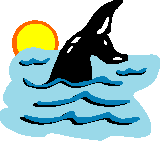 Ocean and Sea Aquatic Zones Ocean and Sea Aquatic Zones
|
Key Characteristic of Oceans and Seas
- Oceans and seas are salty because they contain sodium chloride (table salt; NaCl) as well as other salts, including magnesium chloride, magnesium sulfate, calcium sulfate and potassium chloride.
- Most nutrients are found near the shores in the coastal systems. They are rare in the open oceans and seas.
- Oceans and seas are tidal. The rotation of the Earth, the centripetal force caused by the revolution of the Earth and Moon, an the gravitational pull of the Moon and the Sun affect the water level and cause tides.
- Oceans and seas are layered in such a way that deep currents flow independently of surface currents. These layers are distinguished primarily by their different temperatures.
|
The Ocean Landscape
- Beneath these layers of water, the ocean floor is constantly being created or pulled back into the warmer mantle of the Earth.
- Trenches and ridges run through the centers of the world's oceans. Ocean mountains dot the floor where volcanic material has punched its way through the crust. These undersea mountains and mid-ocean ridges differ from land mountains. They are formed from basalt, have no sedimentary interior, and are not folded or compressed.
|
Currents
- Ocean currents travel great distances for long periods of time. They are affected by winds, the rotation of the Earth, differences in temperature and salinity, the shape of the continents, the shape of the bottoms of oceans and seas, and the tides.
- The Earth's rotation and the resulting Coriolis force causes ocean water to curve to the right in the northern hemisphere and to the left in the southern hemisphere. Thus currents tend to be spiral.
- The currents run into the continents and "pile up." This pilled up water then moves where it can, traveling along the coast of the land mass or sometimes flowing backwards.
- Differences in temperature or salinity cause differences in water density. Water of higher density flows towards water of lower density.
- Oceans and seas are very deep, and currents are not confined to the surface. Upwelling currents are cool masses of water that rise to the surface to fill areas where water has been forced away by winds or other factors. Such upwelling currents bring nutrients to the surfaces.
- Downwelling currents, caused by the accumulation of excess water, carry heat energy and salinity down to, and then along, the ocean sea or sea bottom. These downwelling currents can travel the entire length of the ocean bottom, causing the mixing of ocean and sea water.
|
Biggest Environmental Challenges:
Overfishing
Global Climate Change
Invasive Species
Habitat Destruction and Pollution
|
Life in the Oceans and Seas
The seas and oceans of the world provide a home for a large number of species, including the humpback whale:
"One moment all I could see was a massive head, 15 foot-long-flippers, and a grapefruit sized eye; then, in a mountainous blur of motion, she swept by, miraculously avoiding contact by inches. With a small gasp I realized that I had been holding my breath, and so had the whale…as supple as an otter – not at all like the stiff images in most books – the whale moved with stately grace, tilting her great eye slightly, ebough to suggest that her approach had been intentional. We had come to Hawaii to observe the whales, and in the first of numerous encounters, I discovered that the term "whale watching" has a double meaning."
- Sylvia Earle, Sea Change, Penguin Putnam Inc.
Oceans and seas are filled with representatives of phyla that never evolved to land. They also include other phyla that returned to water. Hence ocean waters are more genetically diverse than inland waters.
|
|
Back to Describing Your Water Site
Back to Water Index |
 Ocean and Sea Aquatic Zones
Ocean and Sea Aquatic Zones